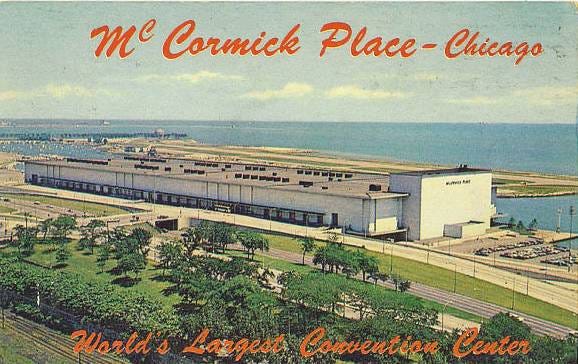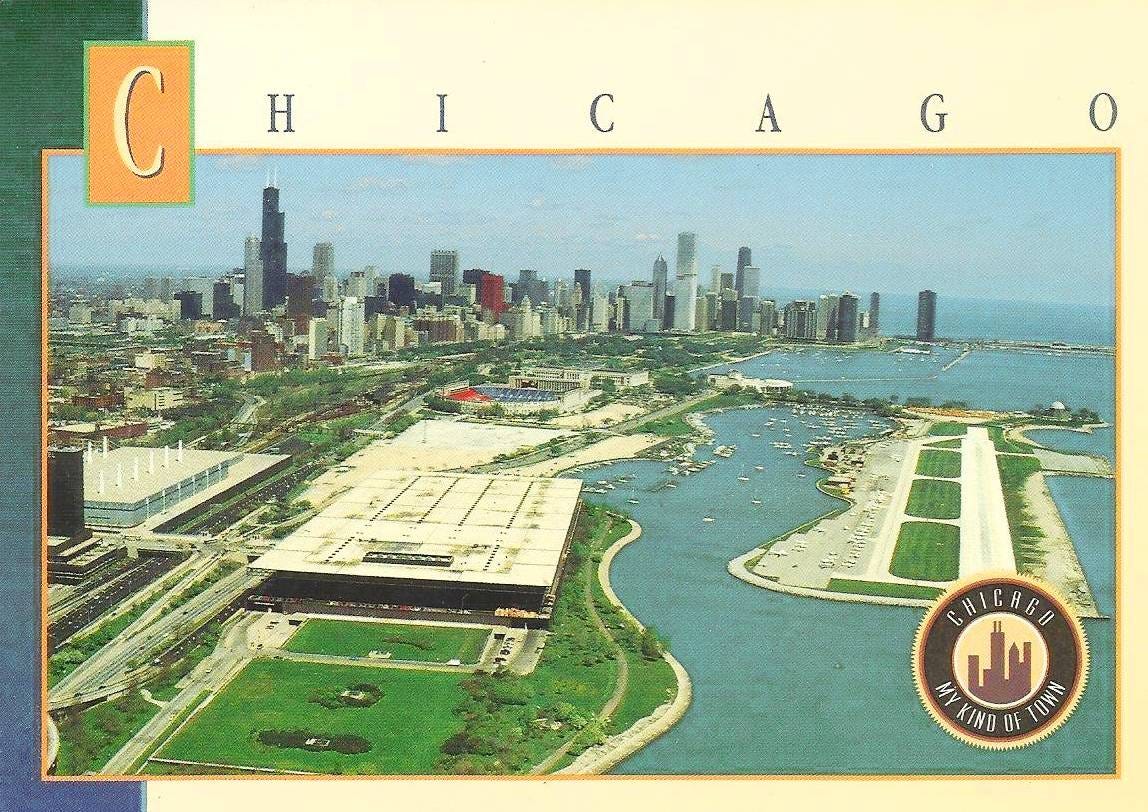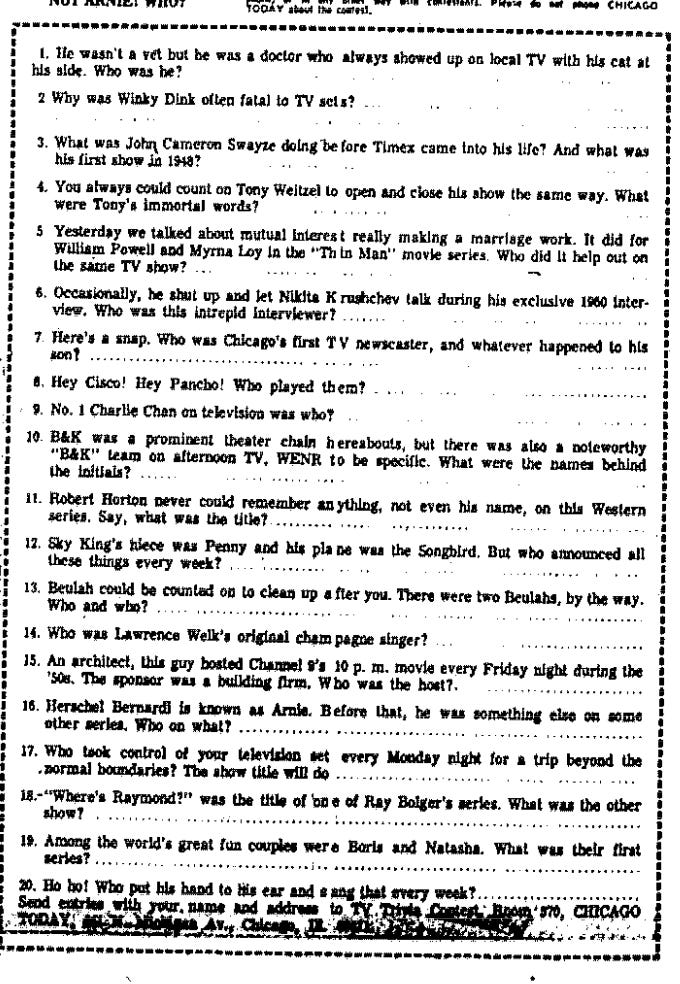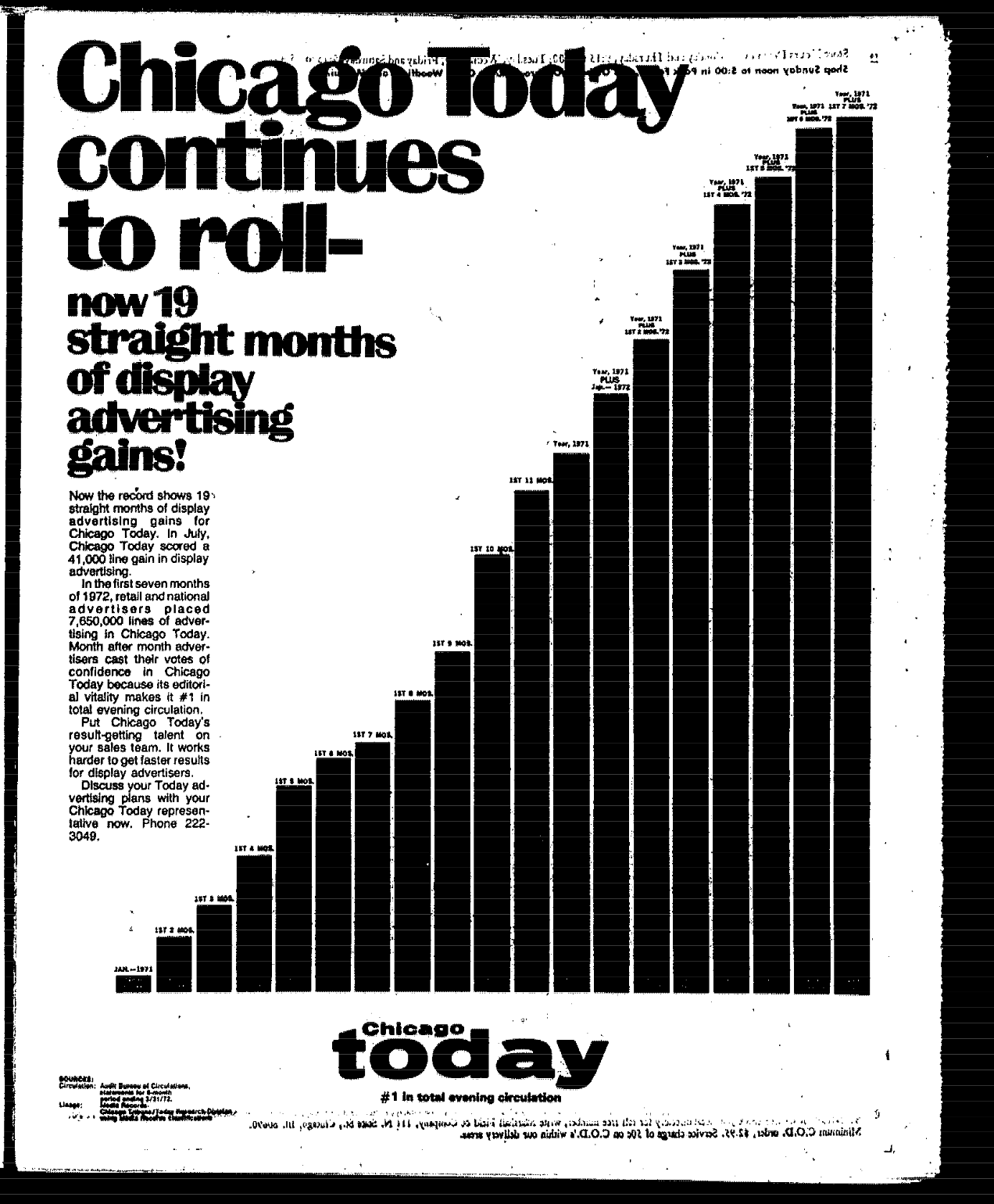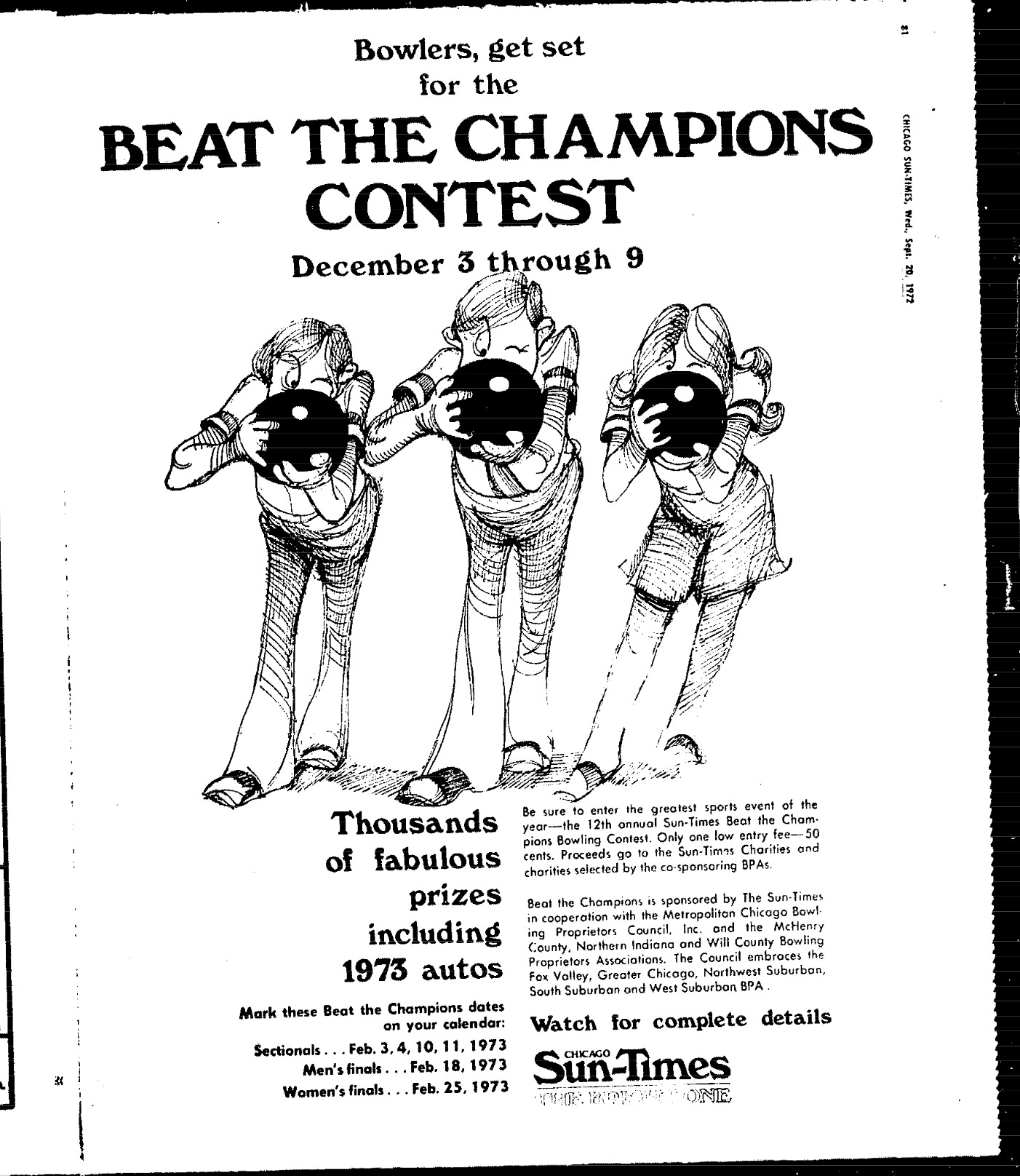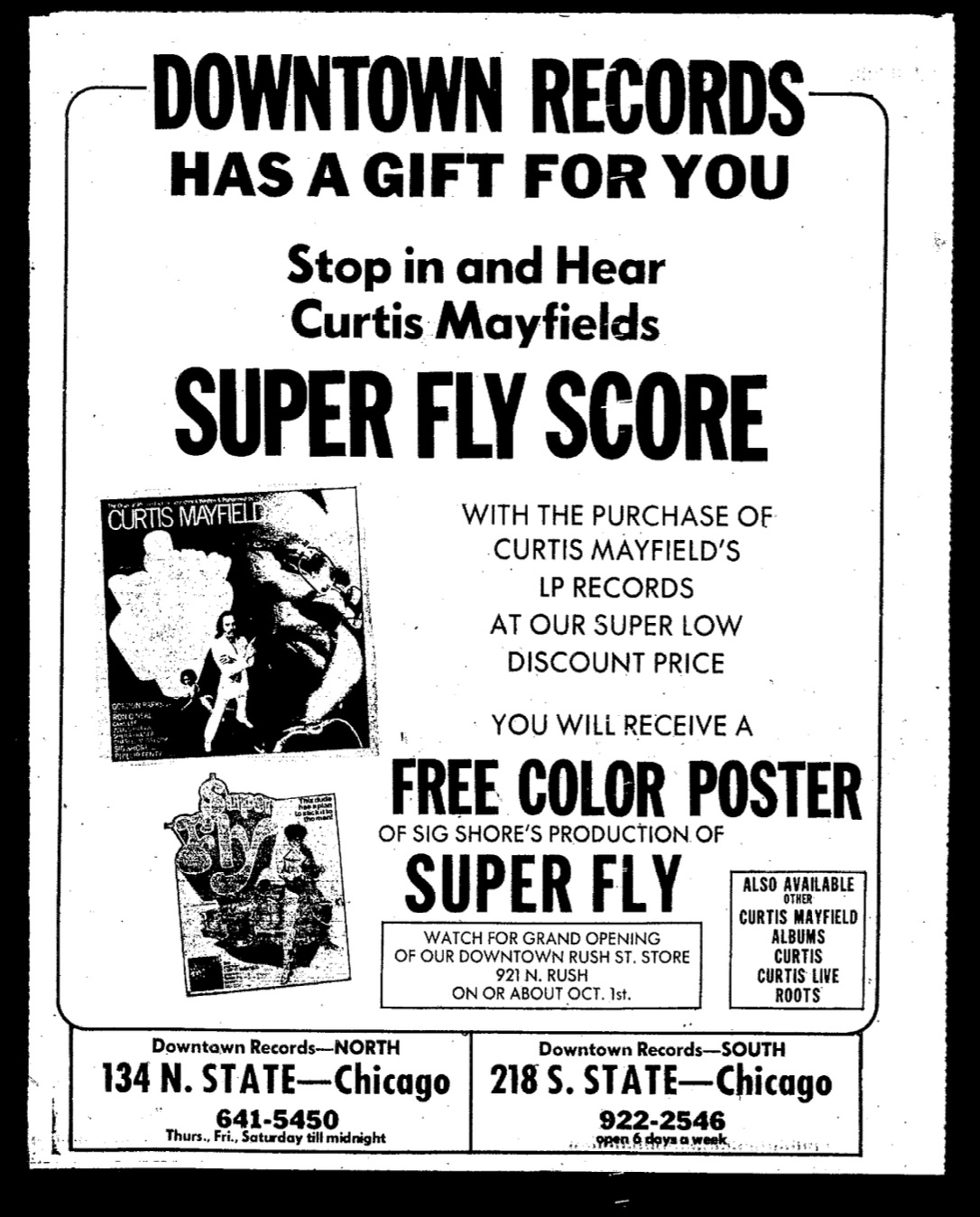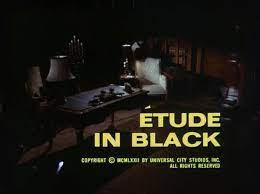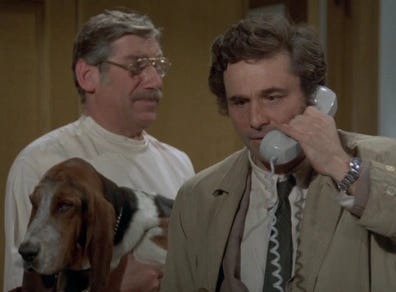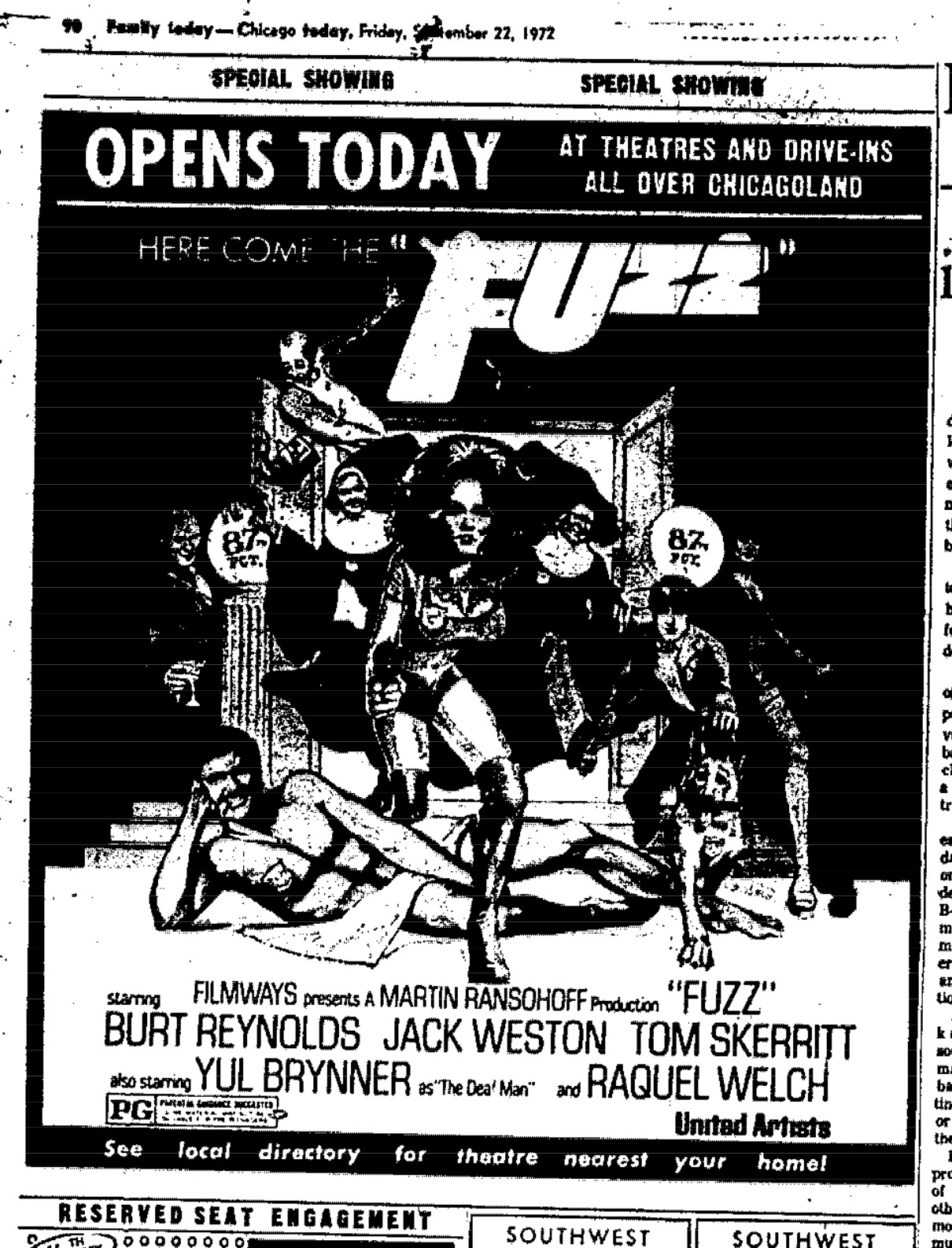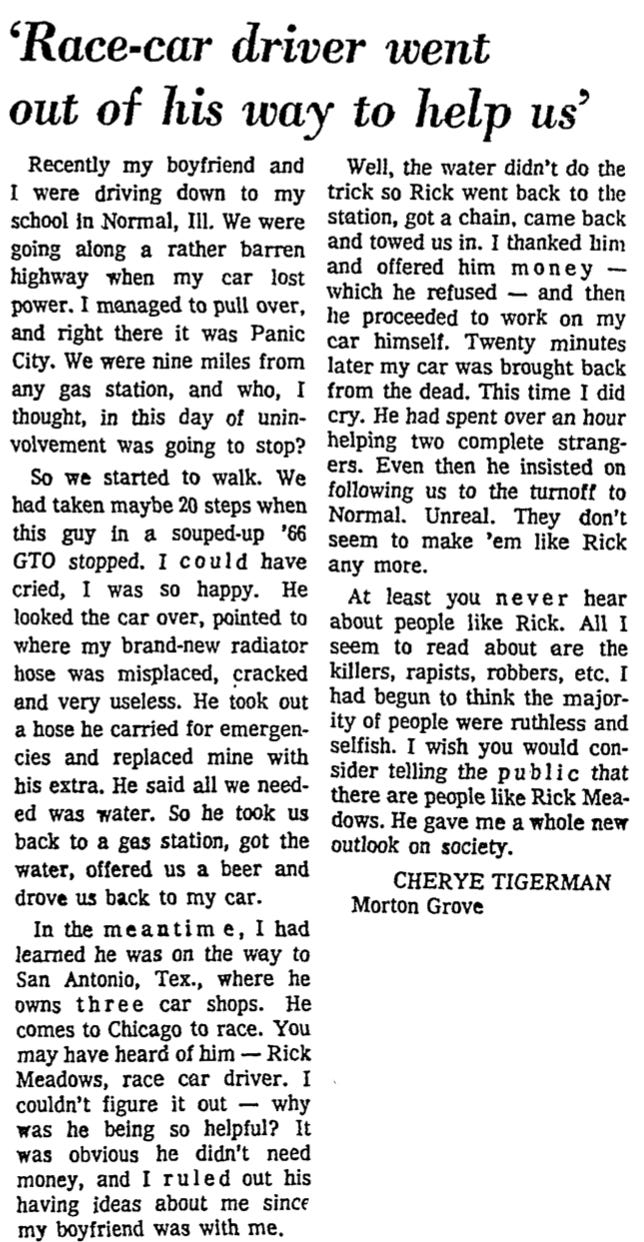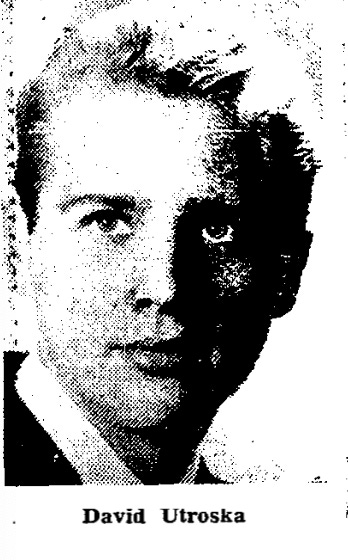THIS CRAZY DAY IN 1972: Trivial Pursuit, 1972 Edition
September 18-24, 1972
To access all website contents, click HERE.
Why do we run this separate item peeking into newspapers from 1972? Because 1972 is part of the ancient times when everybody read a paper. Everybody, everybody, everybody. Even kids. So Steve Bertolucci, the 10-year-old hero of the novel serialized at this Substack, read the paper too—sometimes just to have something to do. These are some of the stories he read. Follow THIS CRAZY DAY on Twitter: @RoselandChi1972.
September 18, 1972
For two weeks now, Chicago papers have been dominated by headlines about massive storms and flooding region-wide. I haven’t focused on these, but regular readers have probably noticed those headlines included on front pages for other featured topics. September 1972 has seen an unusual string of severe storm disasters for Chicago, with cars stuck in flooded underpasses, houses partially submerged in the Fox River Valley, Chicago basements decimated.
Now, the raucous fall weather takes its toll at Meigs Field, the tiny airport on the lake near McCormick Place better known in 2022 as Northerly Island.
Younger Readers, if you’re still not sure where Meigs Field was, here’s a terrific postcard—of course from John Chuckman’s Photos on Wordpress—showing the original McCormick Place at the lake and 22nd Street, with Meigs just past it. The original McCormick Place went up in 1960, and burned to the ground just seven years later.
This 1980s view shows the new McCormick Place, also via John Chuckman. In our 1972 timeline, the new McCormick Place had just opened a year earlier. This shot shows Burnham Harbor as well, with Northerly Island/Meigs Field on the right.
See Chicagology for a terrific look at the origins of Meigs, originally Northerly Island Airport. Here’s a 1950’s shot of Meigs, thanks to Chicagology.
Finally, here’s a view from the lake looking at Meigs, with Burnham Harbor beyond, and the renovated Soldier Field on the shore. This picture
was taken after the second Mayor Daley, Richard M., ordered the Meigs runways ruined with bulldozed X’s in a secret 2003 overnight operation. Mayor Richard M. Daley claimed the airport was a terrorist threat—though Chicago had gotten by for a year and a half after 9/11 without any terrorists taking off from Meigs to attack the Loop.
A Tribune poll in June 2003 found that 2/3 of Chicagoans agreed with me that unilaterally destroying Meigs Field was ridiculous and opposed it. Northerly Island is quite nice, but personally, I liked watching the little planes landing and taking off. Probably most people would vote for Northerly Island in 2022, and maybe I would too.
The morning papers begin coverage of the lakefront tragedy.
by Philip Wattley
The Utroska family of Davenport, Iowa flew to Chicago on Saturday in their two-engine Cessna. They visited Lincoln Park Zoo for son Kenneth’s 10th birthday, which would have been today.
Pilot David and wife Sandra Utroska, both 30, and their three children climbed back into the Cessna at Meigs Field on Sunday just after 6 p.m. They taxied down the runway as another violent storm was brewing. The Utroskas wanted the kids to make it to school on time Monday morning.
The plane “ran into the full force of the storm off McCormick Place,” wrote the Trib’s Philip Wattley.
As the storm hit, writes the Sun-Times’ James Campbell, the “winds suddenly shifted from south to north, blowing up to 50 m.p.h. Federal Aviation Administration officials said the two-engine plane could not take off with the wind at its back and ‘just went into the water’ about 200 yards off the runway.”
Lt. George Tannehill, a Chicago Fire Department helicopter pilot, was standing in the Meigs firehouse doorway watching the storm roll in when the Utroska’s Cessna started taxiing north to make a southerly take-off.
“A tower controller then advised Utroska of the wind shift, suggesting that he take off in a northerly direction, according to Neil Callahan, an FAA spokesman,” per the Sun-Times. “But the aircraft moved off down the runway anyway.”
“I thought for sure that the guy was going to the terminal,” Tannehill told the Trib’s Wattley. “I couldn’t believe anybody would take off in that kind of weather. Then I saw him turn the plane around and head down the runway and I thought to myself, ‘What the hell is that guy doing? He should never take off now.’
“I watched his plane lights go down the runway and disappear. Then we got a call that a sailboat with three kids had turned over. I was going to get the fireboat when the plane crash bell was sounded by somebody in the tower who saw the plane go down.”
“Two fire department jet boats, three police marine units and a helicopter” immediately converged on the scene.
“When we got up there, we saw the oil slick and I knew that’s where the plane had gone in,” said Lt. Tannehill. “We turned our searchlights on and there was nothing, no wreckage at all.”
“Utroska, a commercial pilot, was able to unsnap his seat belt, open a door, and swim to the surface.” The rescuers fished him out of the water, in shock but otherwise unhurt except for minor facial scratches.
“Police and fire department rescue teams were hindered in their efforts as the storm grew in intensity, turning the sky pitch black and the water turbulent.”
Two hours later, Fire Department scuba divers were able to go in. They found the bodies of Sandra and the children—Kenneth, 9; Kimberly, 11; and Kandice, 6—all trapped in the plane, submerged in 25 feet of water.
Utroska was taken to nearby Mercy Hospital. He “kept calling for his wife and children while being treated for shock,” wrote the Sun-Times’ Campbell.
Two funnel clouds formed over Chicago, but didn’t touch down as hail the size of marbles pelted down. Winds knocked down streetlamps in the Loop at Randolph and State, and in various portions of the South Side.
Elsewhere, Humbert DeDomenico, 39, was struck by lightning as he got out of his car at Pensacola and Major Avenues—and survived. A waitress in Morton Grove was struck by lightning as she left work and ran across the parking lot to her car. She did not survive. Lightning struck three homes and set them on fire in suburban Inverness. Over two inches of rain fell on the northwest suburbs in three hours, taking out power for over 10,000 customers.
The evening papers take the story from here.
“What had begun as a special birthday trip to Chicago for Kenneth Utroska, 9, and the family, ended 25 feet below the surface of the dark, choppy lake,” writes the Daily News.
One witness told the News the plane just ran out of runway. The plane never lifted off—it “skimmed only a few feet above the water before splashing hard into the waves about 100 yards south of the field.”
Former pilot William Erickson, 56, of 1130 S. Michigan, was there and told the News the plane “was in trouble all the way.” Normally, according to Erickson, the Cessna should only have needed one-third of the runway for take-off.
Chicago Today says Erickson “watched the crash from his boat moored in Burnham Harbor. Erickson, a printing salesman and former pilot, said…the tail of the plane dipped low about halfway down the 3,800-foot runway while the pilot tried to get it airborne.”
“He must have realized he wasn’t going to make it at the last minute,” Erickson told Today, “because the engine stalled or was cut off just before he reached the end of the runway.” Erickson said the plane hit the water, “bounced up once and then seemed to disintegrate.”
Lt. George Tannehill says the winds were “tornado-like.” Lt. Fred Wirtz and Fire Department scuba divers Carl Liss and Frank Samat were first at the scene by boat from the Meigs firehouse. “They began diving as the heavy rain started and, after several frantic minutes, found the plane as light boats illuminated the area.
“But for Mrs. Utroska and her three children, it was too late.
“The divers moored the wreckage to the bottom of the lake and marked its location with buoys so Federal Aviation Administration officials can begin an investigation today.”
It took over an hour to locate the Cessna Skymaster and recover the family’s bodies.
“My wife and three kids are in the plane,” Utroska told rescuers as he was treated at Mercy Hospital, per the News. “I saw them when I went through the door. They were still in there with their seat belts on.”
Today reports that Utroska is president of a charter, instruction and airplane sales firm in Davenport, and has flown since 1959.
Sun-Times columnist Tom Fitzpatrick got to the scene as the rescue effort was underway.
“In the pitch darkness, firemen in raincoats stood at the southern tip of the Meigs Field runway staring down into the swirling black water,” Fitz opens.
“The wind blew so fiercely the firemen in their raingear and the policemen in short-sleeved blue shirts, braced themselves against it in order to remain in one place.
“The water on the runway was ankle deep.”
About 50 firemen and police were there, all holding their shoulders up “the way people always do to keep off the rain,” writes Fitz. There was little they could do.
A cop walks up to the firemen and asks what happened.
“It’s just silly as hell,” one fireman answers. “He came right down this runway and went off it and right into the lake.”
“Where’s the plane?” the cop asks.
“Well, it should be right about where the boats are. But with this wind it’s hard to tell.”
The rain drives down so hard, writes Fitz, that the firemen seek shelter next to their trucks. “Lightning occasionally lit up the area, showing the outlines of McCormick Place about 150 yards to the right of where the rescue workers were waiting.”
The fire department helicopter hovered overhead and nobody even noticed, because the storm was so loud.
As an ambulance edges past, 1st district Fire Marshal John Casey signals for it to stop. Driver Eugene Chucta gets out and reports:
“The pilot said he got out through the door. He says he got his belt off as the plane was going into the water. As soon as he hit he says he opened the door and got out. He says the plane went right down. He was in the water above the plane when the police and fire boat picked him up.”
Chucta now utters the David Utroska quote that Chicagoans will read in their papers:
“He told me, ‘My wife and my three kids are in the plane. I saw them when I went through the door. They were still in there with their seat belts on. It all happened so fast.’ Chief, when he said that I could see in his eyes how he felt. When he told me that I felt the same way. God, I felt sorry for him.”
Chucta explains that Otruska said he just ran out of runway.
“From then on he just kept saying over and over: ‘I should never have taken off. I should never have taken off. My wife and my kids are still in there. I saw them. They were still strapped in. I saw them as I went out the door.’”
Chucta gets back in the ambulance and drives David Utrosca to Mercy Hospital. Fire Marshal Casey walks off and stares out at the lake, where the divers are now bringing up four bodies. Another fire official walks over.
“Firemen see death more than the rest of us,” writes Fitz. “They can handle it better.
“‘I never get over the wonder of it’, the second officer said. ‘You never know who’s gonna die. There were five people in that plane. How could anyone tell which one of them would come out of it alive?’”
The story of David Utroska will update most days as the week goes on.
September 18, 1972
Chicago Today
Chicago Today began its “First Annual TV Trivia Contest” on Sunday, Sept. 17. This week they’ll print a new quiz each day until Friday, with its own prizes. All answers will be revealed on Sunday Sept. 24, when all winning entries would need to be already in the mail to Chicago Today, 441 N. Michigan Ave., Room 320.
Here’s the front page promo…
And today’s quiz:
Today’s prizes:
“A wagon wheel from the WGN-TV Barn Dance series.
“A cup from WMAQ-TV’s Kup. [Note: Yes, this is Sun-Times columnist Irv “Kup” Kupcinet, but in 1972 newspapers did not deign to acknowledge the existence of their competitors.]
“A big sign reading ‘Sports’ from 2 newscasts.
Three—count ‘em—three cookies which the Cookie Monster on WTTW’s Sesame Street has personally tasted.
These are not very impressive prizes, from a 2022 POV. Would anyone in 1972 have been impressed? I doubt it. This is just for fun.
September 18, 1972
Chicago Daily Defender
You didn’t know Cracker Jack was invented in Chicago? Wish I had time for a full Cracker Jack history, but here’s the link to Wikipedia in the meantime.
September 18, 1972
Chicago Today
We have to take this with a grain of salt, unfortunately, since we know Chicago Today will fold in 1974.
September 18, 1972
Chicago Daily Defender: full page Shell ad for free Bears glass
Shell is running this ad everyplace. Did you get yours, Older Readers?
September 19, 1972
Chicago Daily News
This is how it worked before computers, starting with Craig’s List. And you had to pay for a newspaper want ad, too. $5 for two lines of type, for two days, in both the News and the Sun-Times—which would be $33.75 in 2022 money.
Chicago Daily Defender
The Defender ad would run you $13.16 in 2022 per day, or $15.19 per week.
September 19, 1972: Herman Roberts
Chicago Sun-Times
So far as I can see, this series of ads only appeared in the Sun-Times.
The Roberts Motels had many locations, and the 500 Room comes up constantly in 1972 as the site of fashionable meetings for Black businesses. From the Defender’s September 2-3 issue:
Every week, the 500 Room features performances advertised in tandem with the Gary location’s Pony Lounge. From a June Defender:
Herman Roberts died in 2021 at 97, in Las Vegas, where he had retired for the weather and to be near family, according to his Sun-Times obituary article by Maureen O’Donnell.
Per The History Makers website, Herman Roberts was born in 1924 in Beggs, Oklahoma. His family moved to Chicago as part of the Great Migration in 1936. Herman did odd jobs including washing taxicabs, but soon moved on to driving cabs before buying his own license.
It’s unclear from accounts whether Roberts started a cab business before or after serving in the military. But afterward, back in Chicago, he opened his first club, The Lucky Spot at 71st and South Park (now King Drive) featuring performers like Sammy Davis Jr. and Redd Foxx.
“A few years later, he opened the Roberts Show Club in a garage that once held his cabs,” wrote O’Donnell in the Sun-Times. “The South Side club, also known as the Roberts Show Lounge, featured stars including Sammy Davis Jr., Nina Simone, Sarah Vaughan, Dinah Washington and Jackie Wilson.”
Most accounts say Herman Robert built his first motel in 1960 in order to house performers and guests, since Blacks weren’t welcome at downtown hotels. The Roberts Motel at 301 E. 63rd St., with the 500 Club, was the jewel in the crown of South Side Roberts Motels.
According to the Sun-Times, Roberts bought back land his relative were swindled out of and enjoyed working his ranch there for many years as he ran his Chicago businesses. The History Makers wrote that Roberts “bought land that had once been an oil field and built a house in his hometown of Beggs. He drilled for oil and struck it in 1981. Roberts then sold his motel business, converted the bowling alley to a skating rink and concentrated on his new venture — he still operates two derricks.”
Roberts had six children during his two marriages, and “acknowledged eleven more” according to his second wife, per the Sun-Times.
Some of the Roberts Motels survive under different names, though the star location at 333 E. 63rd is sadly gone.
September 19, 1972
Chicago Today
“Another day, another dollar,” Chicago Today teases with the Sept. 19 quiz. “Don’t you wish that was what we were giving away in our giant TV Trivia contest? But hold on, there are more interesting prizes coming your way.”
Today’s prizes:
“Your very own Harry Volkman marking pen, which he has used to chalk up the weather on WMAQ-TV.
“Some molding photos of the Kuklapolitan Players, taken as publicity photos some 20 years ago, from WTTW.
“A wood-carved head, swiped from WBBM-TV’s Backyard Safari series. Perfect for use as a weapon.”
If you’re a regular THIS CRAZY DAY reader, you’ll probably want to follow Mike Royko 50 Years Ago Today too.
THIS WEEK IN MIKE ROYKO:
Mike reviews Dick Butkus’ new book, “Stop-Action”! The easiest way to make sure you don’t miss it? Subscribe for FREE.
September 20, 1972
Chicago Today
by James Pearre
Phosphates recently peaked as an environmental issue. Chicago required any detergents sold in city limits to reduce phosphates to 8.7% by Feb. 1, 1972, and to zero by June 30. Last week we saw an ad for “New Cold Power”—just one of many brands touting the idea that it’s still strong without phosphates. Here’s a current Ajax ad, this one from the Tribune:
Proctor & Gamble has been running the full page ad below everywhere. I won’t even try to make it big enough to be legible. Perhaps the whole point was for P&G to say they ran some public service ads, but they didn’t actually want anyone to read them. Imagine that as a full newspaper page. It looks like an iTunes user agreement.
As the headline above says, the phosphate ban is going well:
“H. Wallace Poston, Chicago environmental control commissioner, told state and federal water quality officials meeting in the Sherman House yesterday that the ban has improved the quality of sewage arriving at the Metropolitan Sanitary District’s three treatment plants,” writes James Pearre.

Poston said phosphate content is down 50% at the North Side treatment plant from the same period in 1971. July phosphate levels went down even further, and should go down again after Jan. 1, 1973, when industries must go no-phosphate too.
Unfortunately, Chicago’s phosphate ban won’t reduce phosphates in Lake Michigan—because the city long ago reversed the Chicago River’s flow, and all our sewage goes south through Illinois rivers.
September 20, 1972
Chicago Daily Defender
What’s better than football? A football contest! You can’t get a concussion or paralyzed! Chicago Today has its Find-The-Ball contest, and now the Defender has this one:
September 20, 1972
Chicago Sun-Times
What’s better than a football contest? A bowling contest! For some people, anyway.
September 20, 1972
Chicago Daily News
“Super Fly” is still a big money-maker, and still controversial.
September 20, 1972
Chicago Sun-Times
It’s fall, which in the olden days meant the premiere of a new television season. So there’s lots, lots, lots of network advertising right now. ABC, NBC and CBBS all have one of these ads every day touting that evening’s prime time shows.
And who can resist a picture of Paul Lynde? Though his show unfortunately is getting awful reviews. Apparently he was not believable as a sitcom dad.
September 20, 1972
Chicago Today: Columbo
Johanna Steinmetz is the main writer to take over “TV Report” since Bruce Vilanch moved on, and she’s an able replacement. Clearly she knows what she’s doing since she gave the 1972 Columbo premiere episode 3 1/2 starbursts. Why her review appears Wednesday for the show that aired on Sunday night, two days earlier, I do not know.
Columbo’s 1972 premiere is “Etude in Black,” starring Peter Falk’s buddy John Cassavetes as a slimy orchestra conductor who doesn’t want his rich wife (Blythe Danner, now best known as Gwyneth Paltrow’s mother) to know he’s cheating on her. Naturally that means he has to kill his big-mouth mistress, the star pianist in his orchestra.
Johanna Steinmetz gives us some interesting details on the making of this episode:
“If you ever doubted TV is just a big board game to the networks (get the most viewers each hour for the least possible expense), the confirmation was in Sunday night’s premiere episode of Columbo.”
“The show was produced to run 90 taut minutes,” writes Steinmetz.
Yes—as all fans of the rotating shows on Sunday night’s “NBC Mystery Movie” know, the episodes were 90 minutes. That goes for “McCloud” and “McMillan and Wife” too. But something funny happened with this episode of “Columbo,” according to Steinmetz.
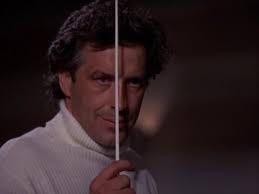
“Then someone at NBC with cold feet and hot palms noticed that a 9 p.m. finish might leave scores of viewers to switch channels to take in the last hour of ‘Goldfinger’ on ABC,” writes Steinmetz. “This, rather than stay tuned for a half an hour of Night Gallery and a half-hour of local programming. The obvious solution was to add 30 minutes worth of script to Columbo, the better to keep viewers in thrall.”
Steinmetz believes the subplot involving a trumpeter who’s initially suspected of the murder accounts for the extra scenes supposedly tacked on just to keep viewers away from ABC’s “Goldfinger.”
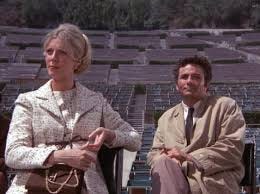
Maybe. But a few clumsy scenes, especially when it involves a false lead, do happen in “Columbo” from time to time. Since Steinmetz doesn’t tell us where she heard this, I’m left vaguely suspicious about whether it’s true. For the producers of “Columbo” to add an entire subplot to lengthen the episode simply in order to go an extra half hour longer to compete with “Goldfinger,” they would have to know ABC’s September 1972 schedule while Columbo was in production.
Also, looking at the timing of Columbo episodes, there’s another episode this season that clocks in at 98 minutes without commercials—the one where Columbo goes to England, with Richard Basehart and Honor Blackman as murderous Shakespearean actors. Half the episodes in the third season will be 98 minutes, or even longer.
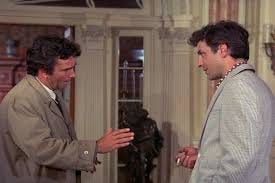
Well, whatever.
“Without these scenes, and assuming they were the added ones, the show was excellent, boasting two of the best guest performances of premiere week,” Steinmetz writes. “As the conductor’s young, naive wife, Blythe Danner gave as good a portrait of female symbiosis as I remember seeing anywhere [Note: Not sure what that means], and John Cassavetes made a stunning villain—slickly sinister, a gleaming viper, truly frightening evening in his charming moments. And Peter Falk is Columbo is Columbo is Columbo.”
Now that deserves a cut-out:
“And Peter Falk is Columbo is Columbo is Columbo.”
I will add—and I can’t believe Joanna Steinmetz didn’t mention it—that there’s a third guest star in this episode: glamorous 1930s-40s movie star Myrna Loy! She’s great as the somewhat stuffy but smart, logical head of the symphony board of directors, and she’s also John Cassavetes’ rich mother-in-law.
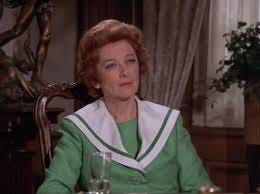
Also, the screenplay is by Steven Bochko, before he was Steven Bochko.
This episode gets in Columbo’s basset hound—he’s just gotten it at a pound—as well as his even frumpier car, which gets insulted by a foreign car mechanic.
September 20, 1972
Chicago Daily News
Everybody hates The Phone Company. So they spend a lot on ads trying to make people like them.
September 20, 1972
Chicago Sun-Times
What the heck is this Marjoe thing anyway? I’ll have to wait until next week to tell you.
September 20, 1972
Chicago Today
So besides Channel 7 news’ happy talk format, they also run their own version of the Daily News’ Beeline and Chicago Today’s Action Line. The fly question is an interesting one.
September 20-21, 1972
“David Utroska went to the Clinton, Ia. Memorial Park Cemetery Tuesday morning,” Chicago Today’s Gregg Ramshaw writes in his lede.
“He picked out a family plot for five persons in the simple burial ground, cleared 37 years ago from the Iowa prairie.
“From there he went to the Snell-Smith Funeral Home and arranged for burial services for his wife and three children.”
David Utroska was supposed to return to his grandparents’ Clinton home afterward, but instead he drove to the new suburban Davenport house that he and wife Sandra had just moved into three weeks earlier with their three children. Some of their furniture was still at their old house. Utroska wrote a note, left it on the kitchen table, then went downstairs into a basement bedroom, laid down on the bed, and shot himself in the heart with a .22 caliber gun.
Quotes from the note, from Chicago Today and the Daily News:
“Sandra can’t take care of the children alone. I know they’ll need me.” — Today
“I don’t feel like living anymore after I killed my family.” —Daily News
Utroska’s airplane business with two partners had been thriving. Besides the new house, he and wife Sandra had just picked up their new two-engine Cessna last week before flying to Chicago to celebrate son Kenneth’s 10th birthday with a visit to Lincoln Park Zoo.
“Utroska was silent during the drive back to Clinton [Iowa] with Nancy and Dennis Gable, Mrs. Utroska’s sister and brother-in-law,” per Today’s Gregg Ramshaw. “He hadn’t wept but seemed rational, tho depressed, during his overnight stay in Mercy Hospital.”
The doctor who treated David Utroska at Mercy Hospital said he hadn’t seemed suicidal, but asked to be released so he could “attend to his responsibilities”.
Now, David Utroska will be buried with his family. His former employer, Larry Straley, tells the Daily News’ Philip J. O’Connor that Utrosca was still in high school when he taught him how to fly. Utrosca skipped college, and by 21, held an air transport rating. He was “one of the most devoted family men I’ve ever seen,” said Straley.
The Sun-Times’ Paul Molloy recounts that when Utroska visited the undertaker, he bought a family plot, saying, “I want to buried with them when the time comes.”
“The time came few hours later,” writes Molloy.
Undertaker Robert H. Snell, writes Molloy, was a friend of Utroska’s who had flown with him many times.
“He was always a cheerful sort of man. But on Tuesday he was in shock, extreme shock,” Snell told the Sun-Times. “He didn’t say much, except he wanted a private service and private burial. And he wanted to see the bodies alone before he left for home.”
After he left Snell’s, Utroska called his relatives, and “what he said alarmed them. They got in touch with another of his friends” who “notified the Scott County sheriff’s police, who went to Utroska’s home.”
The suicide note was a one-page letter addressed to Utroska’s father, Edward, per the Sun-Times. Another quote:
“Life is not worth living without them. My family is my whole life.”
September 21, 1972
Chicago Sun-Times
This is the logo for the section in the center of the Sun-Times. The “family” section runs any articles that in 1972 could only interest a woman—kids, fashion, crafts, cooking—as well as columns like Ann Landers, Dorsey Connors and Erma Bombeck.
This week, the Sun-Times is running promos every day for a new section they call “two”:
Looks like “two” will include articles that only interest women in 1972, plus Ann Landers, Dorsey Connors and Erma Bombeck. But it is a better logo, I’ll give them that.
September 21, 1972
Chicago Daily Defender
September 21, 1972
Chicago Daily Defender: A&P full page ad
These corporate ads in the Defender that come right out and claim they “care” about the Black community are almost creepy from a 2022 POV. After all, we know corporations don’t care about anybody except corporations, which admittedly are now legally people if not communities.
But these ads are better than the recent previous alternative, where corporations didn’t even pretend to care.
Anybody remember the “Madmen” episode where Pete is so proud that he figured out his new television client, Admiral, should do ads aimed at the Black community, because Admiral sales were overall flat but growing in the Black market?
Pete proudly shows his clients copies of Ebony and Jet— “by Negroes, for Negroes…Space in these magazines costs far less than you currently spend…A five percent sales bump in Detroit alone would make you the same profit as a two percent profit system wide.”
Watch the clip for the trick ending worthy of “The Twilight Zone.”
September 21, 1972
Chicago Sun-Times
Speaking of the IBM Building, have you read Chapter 2?
Follow Steve as an adult in 2003 as he walks to work from the IC station at Randolph and Michigan, to his office in the IBM Building. See what’s up with the conference room windows, and meet Steve’s awful boss.
September 21, 1972
Chicago Daily Defender: letter
As the 1972 presidential election draws ever closer, the debate rages over whether Black voters should stick with the Democrats and their candidate, George McGovern, or spread their votes to the Republicans and President Nixon.
The Defender runs the letter below on Sept. 23-24, but let’s see it here to get both sides next to each other.
September 21, 1972
Chicago Today
“How are you holding up under the intense, mounting pressure of our TV Trivia quiz?” asks Chicago Today. “Has your brain turned to putty yet? Have you run screaming from the room, clutching your antenna? Don’t despair! The best is yet to come.”
Today’s prizes:
“Another African wood-carved head.
“A fast-fading picture of John Coughlin as Bosun Bob on the WBBM-TV Susan Show.
“An autographed picture of Len O’Connor.
“A bottle of curling glue from Ione, Channel 7’s own.”
The prizes are not improving as the week goes on.
September 22, 1972
Chicago Daily News
The car ads just kill me. The name “Z Frank” was a Chicago punchline for years, BTW, Younger Readers.
September 21, 1972
Chicago Sun-Times
September 22, 1972
Chicago Today: display ad for “Fuzz”
Note the depiction of Burt Reynolds, who almost certainly does not play his role in “Fuzz” while reclining in the position in which he famously posed nude for “Cosmopolitan” in February.
September 22, 1972
Chicago Daily News
Fields publishing is really pushing the Sun-Times’ upcoming new “two” section, even though it will run the exact same content as the current “family” section. This ad appears in the Daily News, and I’ve never seen the Daily News shill for the Sun-Times before—only the other way around.
September 22, 1972
Sun-Times
September 22, 1972
Chicago Today: tiny display ads at the bottom of a page for Humphreys “11” and Diurex
Diurex, OK. I get it. I understand what it does. But what about Humphreys “11”? And why the quotes around “11”?
It reminds me of the “Mary Tyler Moore Show” episode where Ted’s foxy agent cons Mr. Grant into a new contract that allows Ted to work elsewhere, like TV and movies. Everybody laughs, but then Ted starts doing awful television commercials, aired during the WJM news.
One day, Mary realizes there’s something wrong with Mr. Grant. She follows him into his office to discuss. Mr. Grant doesn’t have the will to go on, because of the awful ads Ted is making and airing on the news. Mary offers Mr. Grant a drink, as I recall, and Mr. Grant refuses even that.
Mr. Grant ticks off the awful commercials as he talks to Mary. There was one, he says, for “a woman’s product.” He didn’t even know what it was. “I asked my wife,” he tells Mary, in the bewildered voice of a beaten man. “She didn’t know either.” I’m paraphrasing from memory there.
Maybe Ted was doing an ad for Humphreys “11.” Remember, “The Mary Tyler Moore” is still a new hit in 1972. It’s possible.
Found it. It’s “Farmer Ted and the News,” Season three, episode 9—which will air on November 11, 1972. Start at the 16:38 mark to relish the whole scene.
September 22, 1972
Chicago Sun-Times
I’m obsessed lately with the fact that people actually managed to conduct business, get jobs and exchange goods using newspaper want ads. But they really did.
September 22, 1972
Chicago Sun-Times

Chicago Today also runs a picture of the plane being raised, but on microfilm it is an undecipherable black square. The caption notes, “The plane was raised from the lake yesterday, while a funeral for the entire family was being conducted in Clinton, Iowa.”
“They buried David Utroska today in the grave he bought Tuesday,” writes the Trib’s David Fortney.
If a more devastating lede exists, I have yet to read it. The conclusion is just as devastatingly simple.
“The 30-year-old pilot, whose plane crashed while leaving Meigs Field Sunday, was buried in Clinton Memorial Park with his wife, Sandra, 30; his son, Kenneth, 9; and daughters Kimberly, 11, and Kandice, 6….He joined them in death only hours after he arranged for their funeral and burial.”
“Cemetery officials said the grief-stricken Utroska picked out a six-coffin plot, pointing out the grave he wanted for each of his four family members. He chose an end grave for his mother, who is buried elsewhere in the cemetery. The grave between those of his wife and son he chose for himself.”
It was a private, 15-minute service conducted by an old friend of David Utroska. The Utroska family’s home was only a mile away from the cemetery.
“Yesterday, heavy winds had swept thru the area, even tearing down trees on the cemetery grounds,” writes Fortney. “One huge ash blocked the main entrance, forcing guests to travel down rain puddled gravel roads.
“Heavy winds had roughed up the cemetery just as they had forced the Utroska plane down. The morning’s overcast sky threatened similar weather, but services were held at graveside as [David] Utroska had requested.
“They were buried beneath a massive oak tree, its leaves rustling in the breeze.”
September 22, 1972
Chicago Today
This is the last TV Trivia Contest. So:
“The time is nigh,” Chicago Today warns. “It’s simple really. We’ve all watched TV for the last 20 years or so. Something must have rubbed off….Answers for the entire week’s mad puzzle will be published Sunday, but there is still time to win the following fabulous prizes for today’s entry:
“A bona fide script from channel 2’s As The World Turns, your very own chronicle of another person’s misery.
“A painting often seen on WBBM-TV. Secret!
“Julia Child’s very own ‘Mastering the Art of French Cooking,’ as she does it on PBS.
“An autographed copy of Joel Daly’s commentaries.”
September 23-24, 1972
Chicago Daily News: display ad for Columbo on Channel 7’s 3:30 movie
What a week for “Columbo” fans—the 1972 second season premiere was this past Sunday night, and now on this coming Monday, Ch. 7 will show the series pilot on the 3:30 movie. It’s not clear why NBC sold rights to the “Columbo” pilot to rival ABC.
Note that Columbo looks pretty young. His hair is surprisingly short and under control. That’s because the pilot aired in 1968, even though the series didn’t begin until 1971. So Peter Falk started playing Columbo during production in 1966, when any adult non-hippy man was still wearing his hair quite short.
If you’re a “Madmen” fan—not to obsess with “Madmen” too much this week but it is a handy point of reference—think about when Pete and the young execs start growing slightly longer hair and sideburns. It’s not 1966.
September 23-24, 1972
Chicago Daily Defender
September 23, 1972
Sun-Times
September 23-24, 1972
Chicago Daily News
It’s just nice to read some good news occasionally.
September 23-24, 1972
Chicago Daily Defender
September 23-24, 1972
Chicago Daily News
Evelyn Wood speed reading was about to become gigantic.
September 23-24, 1972
Chicago Daily News
by Frank Brennan
Just when you think the details about the crash of the Utroska family’s plane into Lake Michigan could not get worse, they do.
Frank Brennan quotes various aviation authorities explaining that contrary to popular assumptions, the personnel at Meigs Field’s control tower could not order David Utroska not to take off in his two-engine Cessna as a violent storm rolled in.
The air traffic controllers can only “advise, recommend or warn a pilot of a critical situation.”
Pilots prefer to be masters of their own ships, Brennan writes, and the controllers don’t want the ultimate responsibility anyway.
The air controller on Sunday did advise David Utroska about the bad conditions and the shifting winds, suggesting that if he insisted on taking off, that he at least use the runway heading north, into the wind.
“Authorities said Utroska acknowledged the advice, but took off with the wind at his tail, fighting to lift his craft off the ground.”
Worse: “Utroska was advised by at least two other persons not to take off, said Ken Course, manager of Meigs Field. They were the counterman at Butler Aviation and the man who drove the family to the plane, Course said.
“Utroska only used four-fifths of Meigs’ 3,945-foot runway for his takeoff, according to Course, failing to use another 400 feet that was available.”
Chicago Tribune
September 24, 1972
In the final Chicago newspaper chapter to the tragic story of the Utroska family, reporter David Fortney attends the funeral and summarizes the week’s events.
“‘His family was everything to David,’ said the Rev. James Galbraith Jr. as he stood beside the freshly dug grave of his long-time friend. The Jehovah’s Witness minister carried a Bible he would use later for the dead pilot’s funeral service.
“‘He was a real good family man,’ the Rev. Mr. Galbraith said. ‘He didn’t feel he had to run around like so many businessmen do today. He wouldn’t even leave his children with baby sitters. They were with him all the time.’”
David Utroska married Sandra Sue Gable in 1959 when they were both 17, writes Fortney, “the same year he finished high school and started his flying lessons.”
David Utroska worked for Larry Straley’s flying service in Davenport for seven years before starting his own business recently with two partners.
“He put in long hours, but he tried to make it up to his family,” Straley tells Fortney. “He wasn’t the kind who would go to the corner tavern every night. He spent his time off with his wife and kids. They were a beautiful family.”
September 24, 1972
Chicago Today: TV Trivia Contest Answers
The microfilm reproduction quality for Chicago Today is just awful. I fear there will be more than one question that somebody was really dying to see answered, and they won’t be able to read it.
Also, I didn’t see any Trivia Contest in Wednesday’s paper. For extra nonexistent credit, take Wednesday’s answers and play Jeopardy—figure out the questions.
Did you dig spending time in 1972? If you came to THIS CRAZY DAY IN 1972 from social media, you may not know it’s part of the novel being serialized here, one chapter per month: “Roseland, Chicago: 1972” —FREE. It’s the story of Steve Bertolucci, 10-year-old Roselander in 1972, and what becomes of him. Check it out here.
Like this post





